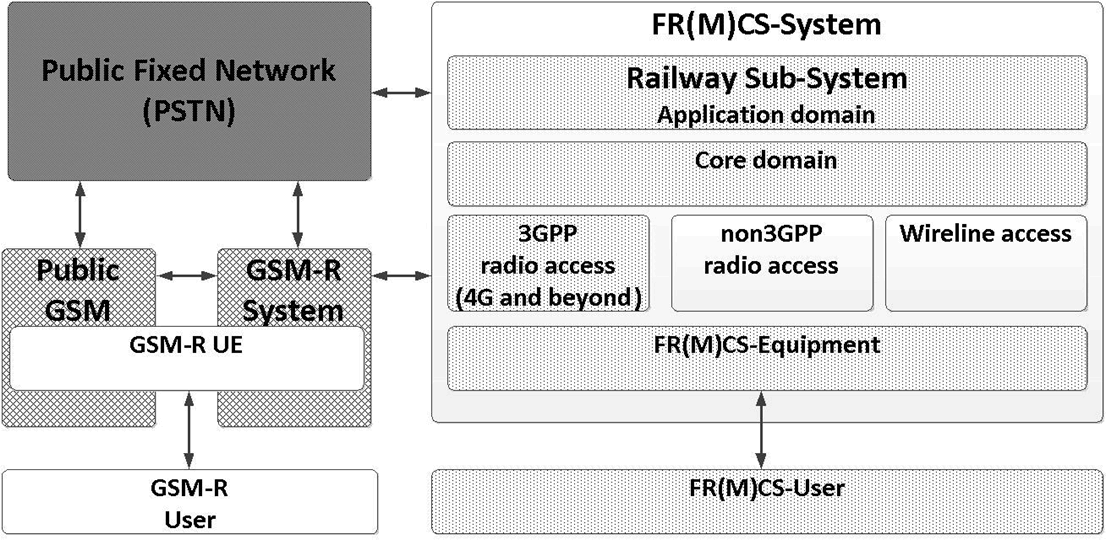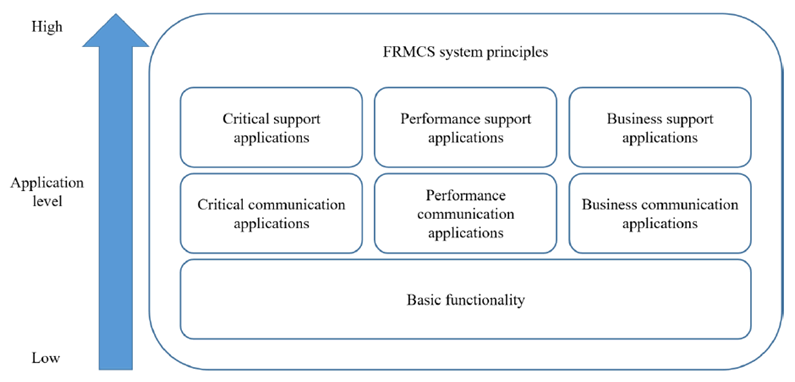Content for TR 22.989 Word version: 19.4.0
4 Overview
5 Basic functionality use cases
5.1 Introduction
5.2 Device power on and shut-down related use cases
5.3 Use case: Power on the UE
5.4 Use case: Access to the FRMCS System to activate the FRMCS Equipment
5.5 Use case: Controlled power down of UE
5.6 Use case: Uncontrolled power down UE
...
...
4 Overview p. 24
The present document is an 800 series Technical Report (TR) written by 3GPP TSG SA WG1 (SA1). Such a TR is not normative, i.e. cannot be used for implementation directly and cannot be referred to by other 3GPP specifications. It was primarily written by SA1 to summarise the high-level communication needs of the railway community and to identify the corresponding requirements, which, in another step have been introduced into normative Technical Specifications (TS) of 3GPP.
An 800 series TR will not be updated when in the process of introduction of the requirements to TS changes are made to those requirements, i.e. the text of the requirements listed here in this TR will not be aligned with the requirements in the TS. Due to the fact that most of the requirements identified in this document were introduced in already existing Mission Critical Communication (MCX) TS, an alignment with the MCX terminology and functionality was made resulting in most of the requirements in here being reworded in the TS. Also, TS requirements changes due to future work affecting requirements stemming from this TR will not result in updates of this TR.
However, the columns "Comments" of the requirements tables listed below were updated to indicate the disposition of the requirement in the TS and most of the time summarising deviations and decisions taken when introducing those requirement into normative TS. By following these references into the normative TS the functionality provided by 3GPP for railway communication can be derived by the reader.
FRMCS will adapt 3GPP transport to provide communication to railway users. It eventually will resemble GSM-R and will additionally provide communication capabilities beyond what GSM-R has been able to. It will provide higher data rates, lower data latencies, multimedia communication, and improved communication reliability. FRMCS considers end-to-end use cases and also provides requirements that might or might not be in scope of 3GPP existing specifications. To facilitate smooth migration from legacy communication systems (e.g. GSM) to FRMCS, interworking requirements between legacy communication systems and FRMCS are provided.
FRMCS Equipment shall connect to application domain through 3GPP radio access or other access. It provides emergency group communication, low latency and high reliable data and video service in high speed train environment. Amongst others it has the following important features:
- Prioritized emergency group communication, train control data and video service
- Seamless connectivity in high speed railway moving environments
- Low latency and high reliable data and video service
- Real time train monitoring and management for safe train operation
- Reliable location tracking including in tunnel tracking
- Legacy railway communication interworking to GSM-R system

Basically, railway communication services [5] can be categorized into
- Train control services
- Maintenance services
- Railway specific services (such as Railway Emergency Call, functional addressing, and location-based addressing)
- Other services (providing train crews or train Drivers with information of train operation and interworking with the existing railway communication systems)
- Basic functionality
- Critical communication applications
- Performance communication applications
- Business communication applications
- Critical support applications
- Performance support applications
- Business support applications
- FRMCS System principles The categories can be depicted conceptually as follows:

5 Basic functionality use cases p. 26
5.1 Introduction p. 26
The basic functionality use cases describe the behaviour of the FRMCS Equipment when powered up and down. For power up it takes the already powered up 3GPP UE as starting point conversely the same applies for power down.
5.2 Device power on and shut-down related use cases p. 26
In this chapter the use cases related to the function Initialisation and shut-down are defined.
- Power on the UE
- Access to the FRMCS System
- Controlled power down UE
- Uncontrolled power down UE
5.3 Use case: Power on the UE p. 26
5.3.1 Description p. 26
This use case provides the user with a powered-on UE.
5.3.2 Pre-conditions p. 26
The UE is switched off.
5.3.3 Service flows p. 27
Successful self-test
The user switches on the UE.
The FRMCS Application performs a self-test. If the test is successful, the user is informed about this.
Unsuccessful self-test
The user switches on the UE.
The FRMCS Application performs a self-test. If the test is not successful, the user is informed about this.
5.3.4 Post-conditions p. 27
The UE is switched on and attached to a 3GPP network following normal 3GPP defined network selection procedures but not logged into any FRMCS System. The user is informed about the results of the self-test.
5.3.5 Potential requirements and gap analysis p. 27
| Reference Number | Requirement text | Application / Transport | SA1 spec covering | Comments |
|---|---|---|---|---|
| [R-5.3-001] | The FRMCS Application shall be capable to perform a self-test and inform the user about the results. | A | N/A | Implementation requirement |
5.4 Use case: Access to the FRMCS System to activate the FRMCS Equipment p. 27
5.4.1 Description p. 27
This use case describes how the FRMCS Equipment registers to the FRMCS System.
5.4.2 Pre-conditions p. 27
The UE is powered on and attached to a 3GPP network but is not registered to the FRMCS System.
The UE has a subscriber identity.
5.4.3 Service flows p. 27
The FRMCS Equipment selects an applicable FRMCS System and logs on to it.
The FRMCS Equipment is initialised by the FRMCS System according to its type.
5.4.4 Post-conditions p. 27
The FRMCS Equipment capabilities are activated.
The FRMCS Application(s) are running on the device.
The FRMCS Equipment is logged in to the FRMCS System
5.4.5 Potential requirements and gap analysis p. 28
| Reference Number | Requirement text | Application / Transport | SA1 spec covering | Comments |
|---|---|---|---|---|
| [R-5.4-001] | When a FRMCS Equipment registers to the FRMCS System, the FRMCS Equipment capabilities are activated and the FRMCS Equipment shall be reachable by its FRMCS Equipment Identity. | A | N/A | Implementation requirement |
5.5 Use case: Controlled power down of UE p. 28
5.5.1 Description p. 28
The UE is powered down.
5.5.2 Pre-conditions p. 28
The UE is switched on and the FRMCS Equipment is registered to the FRMCS System.
5.5.3 Service flows p. 28
The user / FRMCS User initiates power-down of the UE.
If logged in, a FRMCS User is logged-out from the FRMCS System.
The FRMCS Equipment will deregister all identities which are active.
The FRMCS Equipment de-registers from the FRMCS System.
The UE is switched off.
5.5.4 Post-conditions p. 28
The UE is de-registered from the FRMCS System and switched off.
5.5.5 Potential requirements and gap analysis p. 29
| Reference Number | Requirement text | Application / Transport | SA1 spec covering | Comments |
|---|---|---|---|---|
| [R-5.5-001] | When the UE is about to be powered down, a FRMCS User logged into the FRMCS System shall be logged off first. | A | N/A | Implementation requirement |
| [R-5.5-002] | By logging off the functional Role of a FRMCS User shall be deregistered from the FRMCS System. | A | N/A | Implementation requirement |
| [R-5.5-003] | After logging off the FRMCS User, the FRMCS Equipment capabilities shall be deactivated and the FRMCS Equipment shall be removed from the FRMCS System. | A | N/A | Implementation requirement |
5.6 Use case: Uncontrolled power down UE p. 29
5.6.1 Description p. 29
This use case describes the case when the UE is powered down in an uncontrolled way e.g. due to battery failure.
5.6.2 Pre-conditions p. 29
The UE is switched on, the FRMCS Equipment is registered to the FRMCS System.
5.6.3 Service flows p. 29
The UE loses power probably without being able to notify the FRMCS System.
The UE is without power.
The FRMCS System will deregister all identities associated with the FRMCS Equipment.
5.6.4 Post-conditions p. 29
The UE is de-registered from the FRMCS System and switched off.
5.6.5 Potential requirements and gap analysis p. 30
| Reference Number | Requirement text | Application / Transport | SA1 spec covering | Comments |
|---|---|---|---|---|
| [R-5.6-001] | When the UE is uncontrolled powered down, a FRMCS User logged into the FRMCS System shall be logged out from the FRMCS System. | A | N/A | Implementation requirement |
| [R-5.6-002] | By logging out the functional Role of the FRMCS User shall be deregistered from the FRMCS System. | A | N/A | Implementation requirement |